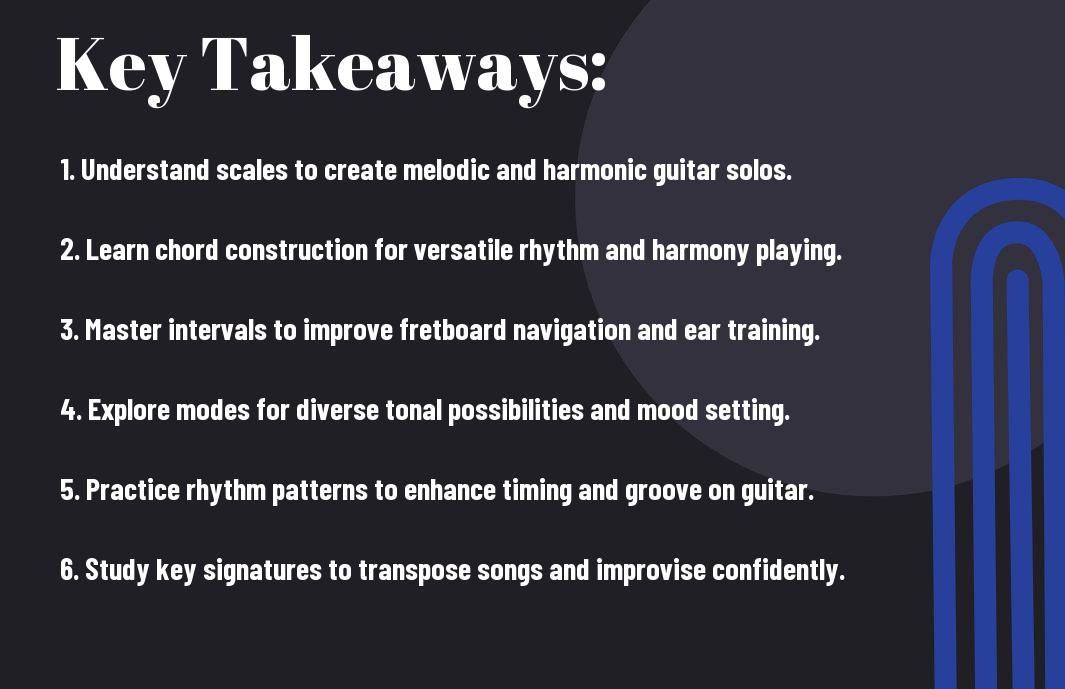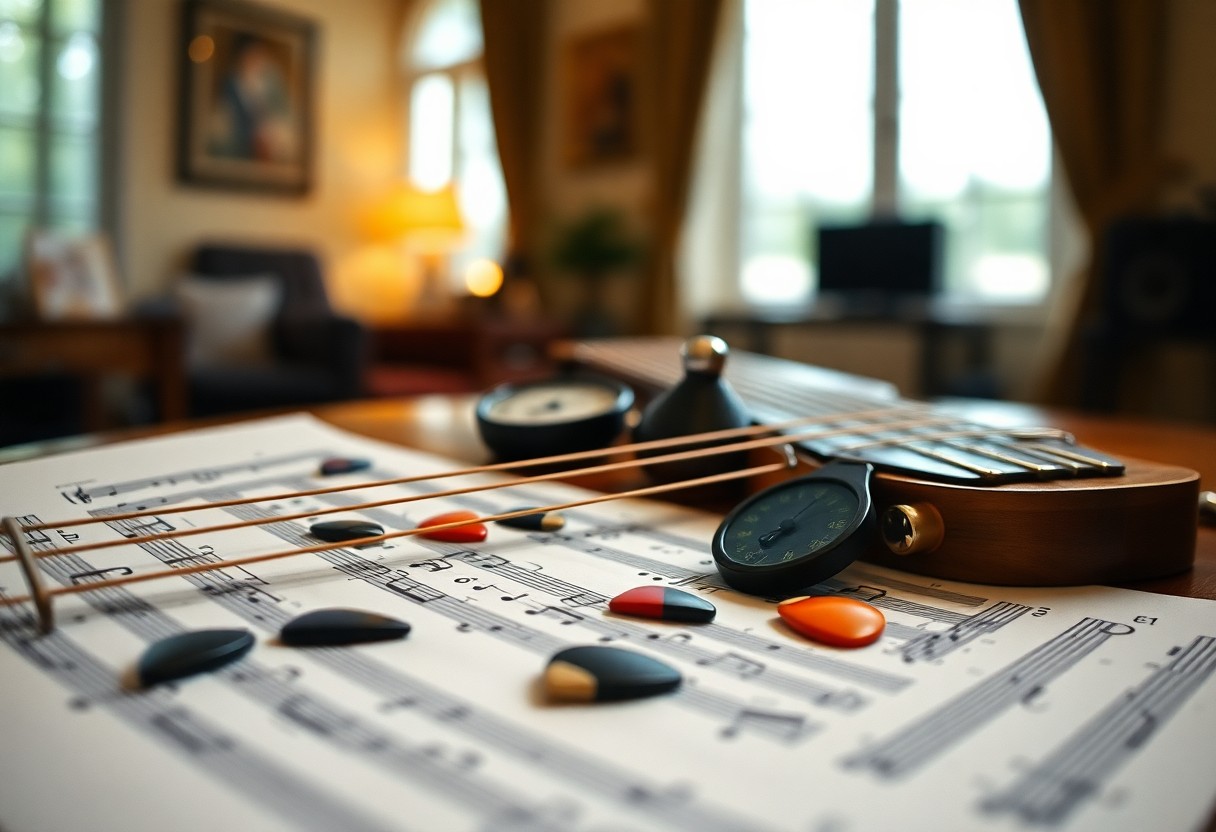As a guitarist, understanding music theory is crucial to unlocking your full creative potential. By grasping the fundamentals of scales, chords, and progressions, you’ll be able to craft your own melodies and enhance your improvisation skills. I will guide you through crucial concepts, helping you see how theory directly applies to your playing. Together, we’ll explore the interconnections between fretboard patterns and musical structures, empowering you to express yourself more freely and confidently in your performances. Let’s dive in and elevate your guitar skills to new heights!

The Core Elements of Musical Structure
Understanding the core elements of musical structure is vital for any guitarist looking to deepen their playing. Comprising rhythm, meter, melody, and harmony, these components work together to create cohesive and engaging music. By learning how these elements interact, you gain insight into composing and improvising, enabling you to craft songs that resonate with listeners. Familiarizing yourself with these concepts lays a strong foundation for your musical journey.
Decoding Rhythm and Meter
Rhythm serves as the heartbeat of music, dictating the pace and flow of your guitar playing. It encompasses a variety of note durations and rests, while meter organizes these rhythms into manageable sections marked by time signatures like 4/4 or 3/4. I find that mastering rhythm can elevate your playing, allowing you to play with more expression and groove, captivating both yourself and your audience.
The Role of Melody and Harmony
Melody and harmony are the twin pillars of musical expression. Melody, often the most recognizable part of a song, guides the listener through the emotional landscape, while harmony enriches that experience by adding depth and context. I have always enjoyed how a strong melody can create an immediate connection, while the right harmonies can shift the mood entirely, whether you’re playing simple triads or more complex jazz chords.
The interplay between melody and harmony is a dynamic and engaging aspect of music. For instance, consider folk songs that often feature simple melodies paired with basic chord progressions. These songs evoke nostalgia and familiarity, illustrating how a catchy melody can thrive with limited harmonic complexity. Conversely, jazz relies heavily on intricate harmonies that can transform a straightforward melody into something more sophisticated and layered. Your understanding of these relationships enables you to create impactful songs, enhancing both your compositions and improvisational skills.
Chord Construction: Unlocking the Building Blocks
Understanding chord construction opens up a treasure trove of knowledge imperative for any guitarist. By grasping the principles behind how chords are formed, you’ll empower yourself to create dynamic progressions and enrich your compositional skills. At the heart of chord construction lies the triad, the primary building block for most chords, serving as the foundation upon which you can build more complex harmonic structures. Grasping these concepts not only enhances your playing but also helps you communicate effectively with fellow musicians.
Major, Minor, and Beyond: Understanding Triads
Triads are the most fundamental chords, consisting of three notes: the root, third, and fifth. With major triads, the third is four half-steps from the root, resulting in a happy, bright sound. In contrast, minor triads have a lowered third, creating a more melancholic tone. Exploring triads in various keys and voicings broadens your harmonic understanding and adds depth to your playing, paving the way for more experimental chord progressions.
Extending Your Palette: Seventh and Extended Chords
Utilizing seventh and extended chords can significantly enhance the emotional impact of your music. A seventh chord adds a fourth note, giving richness and complexity to the sound—a dominant seventh, for instance, introduces tension that begs for resolution. You can move beyond sevens by incorporating ninth, eleventh, and thirteenth chords, which introduce even more colors and subtleties. With these added notes, you create intricate harmonies that resonate deeply with listeners.
Delving deeper into seventh and extended chords allows for greater exploration of musical styles and emotions. For example, a dominant seventh chord can drive blues and jazz, while major seventh chords exude a dreamy quality perfect for smooth jazz or fusion genres. You can also create tension and resolution within progressions by skillfully employing these chords, leading to more compelling compositions. I encourage you to experiment with different voicings, inversions, and progressions to unlock new sounds and textures in your playing. Each added note contributes to the overall tonality, making your music more engaging and memorable.
Scales as a Guitarist’s Framework
Scales serve as the crucial framework for your guitar playing, allowing you to build melodies and solos with confidence. Each scale offers a unique palette of notes that can evoke different emotions and fit various musical styles. Understanding these frameworks not only enhances your improvisation skills but also aids in composition. I highly recommend exploring The Practical Guide to Modern Music Theory for Guitarists for a deeper look into scales and their applications.
The Major Scale Explained: A Foundation for Melodies
The major scale forms the backbone of Western music, characterized by a bright and happy tonality. Comprising seven distinct notes, it follows a specific whole and half-step pattern, which gives it its signature sound. By utilizing the major scale, you can create memorable melodies that resonate with listeners and serve as a solid foundation for songwriting.
Introducing the Minor Scale: Unlocking Emotional Depth
The minor scale is crucial for expressing a wide range of emotions, often associated with darker or more introspective themes. It differs from the major scale by featuring a unique sequence of intervals, which imparts a distinct, melancholic quality. Mastering the minor scale enables you to convey deeper feelings in your music.
Within the minor scale, you’ll find multiple variations, with the natural, harmonic, and melodic minors each offering unique flavors. By experimenting with each, you can unlock countless emotional depths in your compositions. For example, the harmonic minor scale introduces a raised seventh note, giving it a slightly exotic tone that can create tension and resolve effectively in your solos. Incorporating these subtle shifts can dramatically change the emotional landscape of your music, making it more engaging and expressive for your audience. Dive into the beauty of the minor scale and discover how it can reshape your approach to songwriting and improvisation.
From Theory to Practice: Applying Concepts on the Fretboard
Translating music theory into practical application on the fretboard can feel overwhelming, yet it’s where the magic truly happens. By breaking down complex concepts into bite-sized pieces, you can start incorporating scales, arpeggios, and intervals into your playing. For instance, when you learn about chord progressions, try playing them in different positions on the fretboard to see how they interact with various scales. This hands-on approach not only solidifies your theoretical knowledge but also enhances your improvisational capabilities, allowing you to express yourself more freely.
Integrating Modes into Your Playing
Modes open up a world of tonal possibilities for guitarists. Rather than sticking to the common major and minor scales, you can explore each mode for unique sounds. For example, using the Dorian mode over a minor chord progression introduces a jazzy flavor, while the Mixolydian mode brings a brighter, more playful vibe. I encourage you to practice each mode in various positions and along with backing tracks to understand how they shift the emotional palette of your solos.
Creating Meaningful Solos Through Theory
Crafting a solo with depth requires more than just speed and technical prowess; it involves understanding how melody and harmony interact. By applying theoretical concepts—like tension and release from chord progressions or targeting notes that emphasize key changes—you can create solos that resonate emotionally with your audience. Start by outlining the chords and then map out which scale fits over each section; this structure can guide you in building a narrative within your solo.
The process of developing a meaningful solo often reaches beyond simply hitting the right notes. Delve into the intricacies of your chosen key signature and recognize how certain tones evoke specific feelings. For instance, targeting the major seventh of a chord can convey a sense of longing, while a sharp ninth might inject tension. By consciously selecting which notes to play based on their theoretical roles within your progression, you’ll craft solos that not only sound good but also tell a story, engaging listeners on a deeper level.
The Art of Progressions: Crafting Harmonious Compositions
Understanding the art of chord progressions can elevate your guitar compositions to new heights. Harmonic sequences serve as the backbone of your music, setting the mood and guiding the listener through emotional landscapes. Crafting these progressions involves not only knowledge of theory but also a sense of creativity. By experimenting with different combinations, you can discover unique sounds that resonate with your personal style.
Common Progressions That Define Genres
Various genres are characterized by distinct chord progressions that create signature sounds. For instance, the classic I-IV-V progression dominates rock music, while jazz often employs ii-V-I sequences to create sophisticated harmonies. Pop music frequently relies on the I–V–vi–IV chord progression, which can be heard in countless hits. Mastering these common progressions allows you to infuse your compositions with recognizable elements that can connect with audiences.
Building Tension and Resolution in Your Music
Crafting compelling music often hinges on your ability to manipulate tension and resolution. Tension engages listeners and builds anticipation, while resolution provides a satisfying release, leading to a fulfilling auditory experience. Techniques such as using suspended chords, altered dominants, or unexpected modulations can create heightened tension, forcing your audience to lean in closer to hear what happens next. Understanding how to balance these elements empowers you to create dynamic compositions.
By implementing tension and resolution thoughtfully, you cultivate an emotional journey within your music. For example, a well-placed dominant 7th chord can introduce a palpable sense of suspense, urging the listener toward resolution. When the chord resolves back to the tonic, that sense of release not only feels satisfying but also reinforces your melodic themes. A study of songs like “Stairway to Heaven” showcases how dynamics in progressions can evoke deep emotional responses through expertly crafted tension and resolution. You can experiment with these techniques by starting phrases with tension-filled chords and resolving them in ways that feel both surprising and satisfying to the ear.
Summing up
Summing up, as a guitarist, understanding music theory enhances your ability to compose, improvise, and communicate musically. By grasping concepts such as harmony, scales, and chord progressions, I empower you to explore new musical territories and develop your unique voice on the instrument. Diving into music theory may initially seem challenging, but I assure you that it’s a rewarding journey that deepens your appreciation of music and elevates your guitar playing to new heights. Embrace this knowledge, and you’ll find that your creativity and expression will flourish in ways you never imagined.




